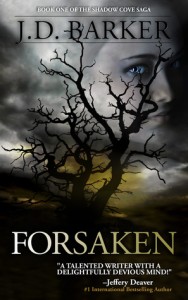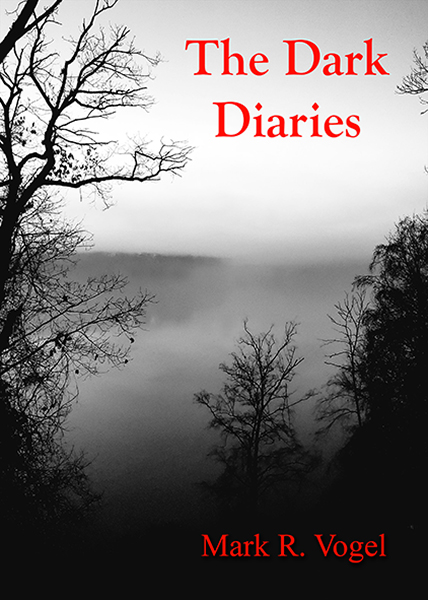
J.D. Barker
Hampton Creek Press
2014
Reviewed by David Goudsward
The premise of Forsaken is that horror writer Thad McAlister’s success has been brought about by the malevolent influence of the 17th century notebook his wife bought him as a gift. Although the bestselling books Thad has written are assumed to be fictional, they were based on actual events, implanted in the author’s mind by the gift, using it as a journal where he jots down his notes. The book is a series of mercifully short chapters (all 103 of them), leaping from the author’s realization that the witch in his latest book is both real and manipulating him to freeing her from her prison, to his family in North Carolina who are under siege by the witch’s minion, to the original witch trial in 1692 Shadow Cove, Massachusetts. The jumps to the past are where the story falls apart.
Barker’s grasp of colonial Massachusetts is particularly weak, starting with the first chapter set in 1692 with the witch trial being held in a church and where Clayton Stone, the witness to the trial, pauses to make the sign of the cross with Holy Water from the font at the entry. Later references include the witch being led into the trial by two congregants bearing wooden crosses doused with holy water, the magistrate making the sign of the cross, and the townsfolk forming a mob carrying crosses and holy water. This suggests a Catholic, Anglican or Lutheran denomination, none of which would be in Puritan Massachusetts. Such a church could not exist and certainly wouldn’t have been the location of a witch trial. That would been held in the local courthouse or at least the meeting house which admittedly also served as the church.
A pet peeve of mine in particular is that Magistrate Tauber is referred to as having burned witches before. If he did, it was not in New England. All the convicted witches, starting in 1647 Connecticut and including the 1692 Salem Witch Trials, were tried under English law, which was in effect in New England. English law dictated witchcraft was a felony, punishable by death by hanging. The Magistrate Tauber’s name is German, so it could be argued he have burned witches for heresy in continental Europe, but a German would never be allowed to be a magistrate.
Then there’s the whole bougainvillea theme, prevalent in both the modern and colonial story lines. Apparently ancient evils from Europe use South American plants in their spell casting both as a component and as a tool, sealing Thad’s wife and daughter in their house by an impenetrable thicket of thorny bougainvillea. How Clayton Stone knew they were bougainvillea in 1692 Shadow Cove is a mystery as the plant was not recorded by Europeans until 1789. Additionally author Barker goes on about the sickly smell and the pink, red, and purple flowers. This is a bit of a problem, since the only bougainvillea with a scent is the Arborea variety, which has no thorns to turn into a thicket, and blooms a light lavender color.
You know a book is in trouble when the prologue destroys the willing suspension of disbelief required for any story to work, regardless of genre. Forsaken opens and closes with chapters featuring Thad’s wife purchasing the cursed journal from Leland Gaunt at the Needful Things shop in Castle Rock, Maine. A passing to Stephen King is tucked into the acknowledgement. Assuming the wording also infers permission, the reader is left scratching his head as to the point of trying to connect this work to Stephen King’s universe. The premise, as hackneyed as it is, works on its own without forcing it into a better writer’s universe.Intrigued by the sheer audacity of the prologue and epilogue, I went looking for more information. The Publisher is a build-your-own website without its own domain name. The website is partially finished, and only has this book listed, in spite claims to have been in operation since 1971. The publisher’s address in Shadow Cove, the fictional town used in the book (located between Kingston and Plymouth, Massachusetts based on context in the book). Thad McAlister, the fictional author-protagonist in the book also has a website, touting his imaginary works (i.e. future sequels) and fake book reviews. Barker, the book’s author lives in the same fictional Shadow Cove, and his college degree is from Beaumont University, which was invented to help market King’s Red Rose mini-series in 2002. Even the cover from a book-cover design company includes testimonials from happy customers, including a glowing endorsement from the fictional Thad McAlister. As a reviewer, I don’t care if a book is from a major publisher or self-published. But don’t insult my intelligence with obfuscation and sock puppets. It makes me wonder if the author is unsuccessfully trying to be clever or lacks faith in the book to the point of obscuring details about the publisher and author.
The ending telegraphs the opening of book two (the cover carefully notes this debut is only book one). Let’s hope that the author devotes little less time to feckless marketing ploys and more time to story development.
A copy of Forsaken was sent in by a site sponsor.
- Strange Blood: 71 Essays on Offbeat and Underrated Vampire Movies – Book Review - July 12, 2019
- The Ren Faire at the End of the World – Book Review - January 12, 2018
- Ghostly Tales – Book Review - December 21, 2017
- Death and Douglas – Book Review - September 12, 2017
- Northern Frights – Book Review - May 1, 2017
- Cannibalism: A Perfectly Natural History – Book Review - April 27, 2017
- SNAFU: Unnatural Selection, Edited by Amanda J. Spedding and Geoff Brown – Book Review - January 19, 2017
- Sweeney Todd – The String of Pearls: The Original Victorian Classic – Book Review - December 29, 2016
- Whispers by Kristin Dearborn – Book Review - December 21, 2016
- He Sees You When He’s Creepin’: Tales of Krampus – Book Review - December 15, 2016


